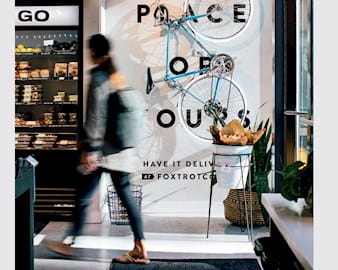In the wake of COVID-19’s arrival, a whopping 75 percent of consumers have changed their shopping behaviors, and four in 10 have reduced their overall spending. Big purchases are being delayed, nonessential acquisitions are being scrapped, and the majority of households expect their shopping habits to permanently shift, putting the squeeze on businesses big and small. With over 90 percent of executives likewise expecting the impact of the coronavirus to fundamentally change the way in which they do business, according to recent research by McKinsey & Company, the consensus is in. As nearly nine in 10 executive leaders note, the pandemic is expected to produce a lasting shift in customers’ purchasing patterns that wxill continue long after its economic and social effects recede.
“The pandemic has shown the fragility of optimized systems such as grocery supply chains,” noted professor of marketing Oleg Urminsky. “When shutdowns started in early to mid-March, customers drastically changed their shopping behavior. . . . Then, after a few weeks, their behavior shifted again. In the future businesses may need to have more flexibility in their systems to be able to respond to sudden changes like this in the marketplace.” (See “Illuminating Dramatic Changes in Grocery Shopping,” below, for more on Urminsky’s research.)
While the pandemic’s economic impact is upending traditional operating systems and business models, these seismic shifts can also drive forward-thinking firms and business leaders to spark new transformations that can benefit consumers.

“Disruption and change may be uncomfortable, but they are also powerful catalysts for innovation,” reminded Sumit Singh, ’14, CEO of popular online pet retailer Chewy, headquartered in Dania Beach, Florida. “While we must anticipate continuing external disruptions, we can also excel as business leaders by introducing innovations of our own, in service of our customers and employees alike.”
Catalyzing Change at Chewy
For Chewy, evolving in response to the challenges of the pandemic not only included introducing new “Connect with a Vet” telehealth services to provide medical advice to pet owners stuck home on lockdown. It also meant rapidly transitioning its 2,000-strong team of customer service agents to a nearly 100 percent remote work environment, and quickly shifting to methods of communication with shoppers that are primarily driven by digital mediums such as online chats, emails, and social network exchanges. As a result of these unexpected shifts, a company initially envisioned primarily as a simple and convenient place to purchase toys, kibble, and treats has since grown to become a promising source of pet-related services of all kinds, and the largest e-commerce pet pharmacy provider in the country.
Learning to apply leaner and meaner operating strategies, embrace a scrappier business model, and leverage technology innovations more capably in the face of disruption can help organizations stay one step ahead of the curve, Singh noted. Likewise, he advised, it’s also vital for executives hoping to successfully navigate uncertainty to embrace new industry advancements as well. In keeping with these shifts, this past October, the company rolled out its first fully automated fulfillment and distribution center, in Archbald, Pennsylvania, which is anticipated to reduce fulfillment costs by a third and improve operations efficiency by up to 45 percent.
Buoyed by these and other changes the company has made, Chewy’s stock price more than doubled in 2020, the company’s workforce grew to over 18,000 people, and the publicly traded company continued to notch up multiple quarters of record-setting customer growth. Skyrocketing interest in pet adoption and consumers’ reliance on online shopping have also led to significant gains for Chewy’s shareholders, a turn of good fortune that the company has made a point to roll right back into its community. The firm has since donated more than $30 million in food, medication, and supplies to GreaterGood.org and other animal welfare organizations and rescue centers to help these organizations weather the ongoing pandemic.
Still, any business’s fortunes can wax and wane faster than ever in today’s environment of sudden and unexpected change. The surest way to keep up with fast-changing times and trends isn’t to continue repeatedly applying the same historical business strategies and solutions in the face of rapidly evolving markets, Singh suggested. Rather, it’s to use uncertainty and disruption as sources of motivation to proactively disrupt yourself before competitors do. Likewise, he said, it pays to leverage emerging socioeconomic changes as a catalyst to evolve your own strategies in time with shifting customer needs and competitive landscapes.
“There are two specific qualities that leaders must display now in order to stay one step ahead of the curve,” Singh noted. “The first is the ability to anticipate what’s coming next, and the second is the ability to think big and invent.” At Chewy, Singh encourages leaders to stay close to their customers using metrics and insights, and to think bigger and rapidly innovate on behalf of their clients. “Customer centricity must be infused into your corporate culture, along with a shared sense of mission to deliver an exceptional experience every time,” he said. “Your entire organization should practice these principles every day.”

Leading with Innovation
One company that’s been quick to adapt in light of recent changes is upscale convenience store chain Foxtrot, whose popular markets sell in house and deliver a curated selection of groceries and meals to shoppers’ doorsteps. “Being a CEO, I’m constantly focused on new and emerging trends, and ways to get my teams thinking about how high-tech innovations like cashier-less checkouts and social shopping are going to impact our business model,” noted cofounder Mike LaVitola, ’14. “As a modern executive, you need to read voraciously, spend time speaking to innovators in complementary fields, and really do your homework here.”
Originally launched in 2013 as a beverage delivery app for students, the trendy Chicago-based retailer and foodservice staple has spent 2020 finding ways to stay more closely dialed into its customers—and the insights they can provide. Since COVID-19 hit, the company has begun to roll out contactless delivery options, on-demand café pickup options, and new shipping capabilities, among other advancements. But perhaps the firm’s biggest windfalls have come through enhancements to its frequent-shopper loyalty program, for which it has created unique, time-limited offers designed to boost app-based traffic and online sales. To date the program has delivered a 30 percent sales uptick in featured category items, delivering welcome wins for the organization in a time of great uncertainty.
LaVitola credits part of Foxtrot’s ongoing success to understanding its core value proposition: fast and convenient access to top-quality, handpicked offerings and items. In navigating, he relies on the lessons he learned at Booth, as well as a close focus on customers’ changing needs and interests.
“COVID-19 has fundamentally changed the way in which we work, but despite the challenges that 2020 brought, it’s also helped drive innovation across the board,” LaVitola explained. “Our real-estate team has uncovered new, unbelievable store locations and reinvented our store format to drive our dayparting business [ad-driven promotions scheduled on the basis of a time of day].” When COVID-19 began preventing in-person celebrations and gatherings, LaVitola’s team observed many customers sending gifts to each other. “Our merchandise team reinvented gifting and expanded our selection of organic wines, driving 25 percent more sales,” LaVitola said. “We expanded our gifting options, driving average order value up by 10 percent in the process.”

In other words, said LaVitola, a business’s ability to respond to disruption is largely a matter of its willingness to take an objective look at itself and its capabilities in light of new events, and its willingness to make necessary changes. “At Foxtrot we’ve chosen to respond to the pressures that the pandemic has presented with a strategy of inspired creativity, deep collaboration, and organizational alignment. It’s more important than ever to stay dialed into clients’ needs.” No matter how uncertain times like these are, he noted, “your customers will tell you what they want—it’s up to you as a business leader to really listen.” Bearing this in mind, it’s important to encourage employees who interact with customers regularly to speak up and share their feedback and insights. As a business, LaVitola said, it’s vital to be “really connected internally,” and implement platforms and programs that can help clients themselves have a voice in your transformation process.
Designing Better Customer Experiences
Also important for organizations to note: flexibility and agility are only becoming more crucial to strive for, as the need to pivot on a dime will continue to grow in 2021 and beyond. “You need to find ways both to be hyper-dialed into your customer’s needs and to move more quickly on these insights,” explained LaVitola. “Curiosity is essential: I’m constantly thinking about how emerging technologies and trends and new industry developments are going to impact our business model.”
But while technology promises to provide organizations with the flexibility needed to adapt to unexpected developments, many businesses continue to struggle to keep up with the pace of technological change happening today. However, learning how to effectively adopt and implement future-focused high-tech innovations will only become even more critical to maintaining long-term business success in coming years, long after the pandemic recedes. “The shift in consumer demand toward online channels has accelerated dramatically due to the pandemic,” said Singh. “Customers will only continue to demand more from companies, who must rise to the challenge of minimizing supply chain disruption and offering myriad solutions.”
Staying attuned to changes in the marketplace and customer habits (which technology allows you to monitor and predict) is vital to remaining agile and competitive, he asserted. Thankfully for firms of every size in every field looking to reinvent or reposition themselves to thrive in coming years, a host of new technologies offers solutions for staying ahead of unexpected developments. Technologies such as artificial intelligence, data analysis tools that can help you make smarter decisions, and business process automation solutions that streamline operations will only become more vital.
Of course, all the new technologies and groundbreaking apps in the world ultimately mean little if you can’t translate their upsides into actionable business strategies, reminded Singh. That’s because customer experience is everything in tomorrow’s commercial world. “Customers expect us to be authentic and trusted advisors,” said Singh, noting that this applies to internal customers in every business department as well. But while 82 percent of marketers feel that their brands are living up to customers’ expectations, just one in 10 clients actually agrees, according to a consumer experience survey by SaaS firm Acquia. It’s imperative to also keep a laser focus on what counts most as an organization, said Singh: finding ways to create customer experiences that audiences will adore, that will inspire shopper loyalty, and that will continue to keep buyers coming back for more.

For instance, Chewy not only invested in robotic and automated order fulfillment as a way to speed up order processing (among other benefits), but it also brought an internal team of mechanical and industrial engineers and order fulfillment experts together to help minimize warehouse staffers’ workloads, boost workforce productivity, and minimize downtime. That meant not only improving fulfillment speed and accuracy—it also meant finding ways to remove congestion and optimize workflows to promote greater social distancing and safety. “Customer centricity must be something that your entire organization practices and acts upon every day,” said Singh. “Scaling is meaningless as a business if you fail to deliver on that promise.”
If you’re looking to design customer experiences of your own that connect more readily, Singh and LaVitola both advised applying a mix of low- and high-tech strategies to innovate. For example: use analytics and customer data to glean crucial insights and know where to focus your company’s efforts; create internal opportunities for workers close to customers to share their insights and feedback (e.g., internal message boards or innovation contests); and offer vehicles through which customers can actively get involved and provide insight and feedback as you go about crafting new programs and solutions. Likewise, they also recommend hiring employees who are curious and capable problem solvers, promoting a corporate culture of accountability and service, and actively rewarding employees for their commitment to customer success, to reinforce the practice of positive habits at every turn. Finding ways to shout out and recognize staffers who go the extra mile, they said, can provide a simple yet powerful incentive for workers to maintain a consistent customer focus. In effect it’s crucial for companies hoping to thrive despite ongoing disruption to make a commitment to customer experience that needs to come from the executive suite down, and for leaders to model the behaviors they’d like to see reflected in their staff at all times.
“Attentiveness and intentionality in building the right culture is paramount to any business,” noted Singh. “Ingenuity, resourcefulness, and empathy should remain at the forefront of your approach, and leaders should focus on delivering new solutions for customers, partners, and team members. Empowering other leaders to help elevate their performance is a critical factor in achieving future success.”
Future-Proofing Your Business: Putting the Pieces Together
When it comes to continuing market volatility and ongoing disruptions brought on by COVID-19 and growing economic upheaval, it’s anyone’s guess what the future will bring. But as both Singh and LaVitola suggested, if you simply keep an open mind and remain flexible as a business leader, while also implementing a mix of high- and low-tech innovations that can keep your company well-informed and nimble, the challenges presented by an increasingly unpredictable business environment can become more manageable than you’d anticipate.
Foxtrot recently launched the Up & Comers Small Makers Awards, an initiative that allows food, beverage, wellness, and self-care startups to gain much-needed exposure and distribution. Under the terms of the program, small and local businesses can submit products to be reviewed by a panel of judges, who can award cash prizes, mentorship, and even coveted spots on Foxtrot Markets’ store shelves. Repositioning its physical locations to not only offer customers brand-name selections, but also serve as incubators for promising upstart brands, offers all parties deeper insights into what resonates with modern shoppers—and more opportunities to adjust and improve their business strategy accordingly.
Granted, like operating conditions, customer habits and preferences will continue to evolve throughout 2021 and into the foreseeable future. If you want to stay ahead of the curve, it’s critical to remain positive. Tomorrow’s most successful business leaders will take a relentlessly practical approach to problem-solving, with an eye toward steering their organizations toward (or back to) success, whatever the future brings. “Forces such as COVID or others that cause disruption bring with them ambiguity and uncertainty,” Singh said. “It’s now more important than ever for leaders to remain optimistic and singularly focused on their company and mission. Across the business landscape ingenuity, resourcefulness, and empathy must remain at the forefront of your strategy, and leaders should focus on delivering forward-thinking, new solutions.”
Illuminating Dramatic Changes in Grocery Shopping
Throughout 2020, as business leaders responded to ever-evolving challenges on the ground, researchers from a variety of disciplines at Chicago Booth dove into the data to illuminate new insights about the pandemic’s impact—from the economic impact of stimulus measures, to ramifications for the US labor force, the effect on markets, and much more.
Professor of marketing Oleg Urminsky, along with the University of Michigan’s A. Yeşim Orhun, used Nielsen Homescan Panel Data to look into how the pandemic affected consumers’ grocery purchasing and stockpiling habits, analyzing how shoppers’ behaviors changed during the early weeks of the pandemic and the lockdown period that followed.
They found that consumers drastically changed their shopping habits to stockpile, substantially increasing both the number of shopping trips they made and how much they purchased in each trip, compared to their prior shopping patterns. “Think of shoppers with overflowing shopping carts, coming home and stuffing the freezer and the cupboards,” said Urminsky. “Then, after a few weeks, their behavior shifted again, into lockdown mode, making fewer but larger shopping trips than they normally would.”
Interestingly, the pair found that these changes in behavior were not consistent across different shoppers. “In particular, lower income shoppers changed their behavior less—doing less stockpiling, and less reduction in trips but increasing in amounts during the lockdown period,” said Urminsky. “We think this occurred because low-income consumers had less financial ability to shift their shopping, and as a result, low-income consumers may have been less prepared for the pandemic.”
Leading Amid Unprecedented Disruption
Amid the tumult of 2020, the observation that these times are unprecedented has become a cliché. But as 2021 dawns and new changes and challenges continue, it will be critical for leaders to keep a level head in the face of disruption—at least until “these times” can be a little more “precedented” again.
Here, Chewy CEO Sumit Singh, ’14, and Foxtrot CEO Mike LaVitola, ’14, offered their best advice for staying calm when things are topsy-turvy.
- Stay laser focused on customer needs using technology tools, online surveys, and direct one-on-one feedback. Shoppers’ interests and operating realities can now shift on a dime. Understanding the pain points they face now, and even predicting what challenges they’ll face next, can help you uncover new ways to make yourself essential, said Singh.
- Seek cost-affordable methods of experimentation and learning. Testing out pilot programs or a minimum viable product can prove a helpful way to rapidly source insights from your target market and increase the odds of finding success with new ventures, the pair emphasized.
- Apply measurable metrics to every choice you make so you can track and continuously improve products, processes, and programs, noted LaVitola. Don’t be afraid to revisit and revise your strategies and approaches as you gain more feedback and information.
- Be a curious optimist, and an eager learner. Operating conditions and situations on the ground can shift rapidly right now. In the event of an unexpected setback, remember: a simple pivot could help you right the ship again, LaVitola and Singh reminded.
Data-Driven Innovation
Staying focused on customer needs and making data-driven decisions is only possible if you have access to data-driven insights on consumers to inform your decisions. With data now the lifeblood of any modern organization, Chicago Booth’s James M. Kilts Center for Marketing has established an exclusive relationship with the Nielsen Company to make sweeping information on consumer purchasing trends available to academic researchers worldwide.
This comprehensive marketing database goes back to 2004, with regular annual updates. The available marketing datasets are compiled on the basis of 40,000 to 60,000 consumer household panelists, reports from 35,000 to 50,000 participating retail stores, and myriad online and real-world advertisements and surveys. These datasets have already fostered hundreds of working papers, many of which have been published in leading academic journals.
Using these datasets—which shed insights into hundreds of topics, from consumer goods to housing and employment—researchers in multiple disciplines can effectively cross-reference and explore purchasing dynamics in context to surface actionable business insights.
Recently a group of researchers—including Michael Weber, associate professor of finance and a Fama Faculty Fellow; professor of marketing Oleg Urminsky; University of Chicago Harris School of Public Policy’s Dmitri Koustas; University of Texas’s Olivier Coibion; and University of California at Berkeley’s Yuriy Gorodnichenko—were able to assess how COVID-19 has impacted household grocery inventorying behavior. Using information from the Nielsen datasets, they discovered marked shifts in consumer habits over time.
Given the size, scope, and breadth of these datasets (additionally fueled by findings piped in straight from in-store buys), insights can also be leveraged to see how customer habits and needs are changing in specific locales and geographic territories.
The Kilts Center’s relationship with Nielsen is currently making powerful insights such as these available to more than 1,300 researchers from a range of disciplines and representing over 75 universities around the world.


